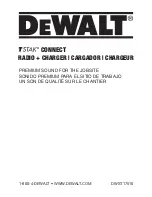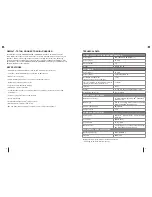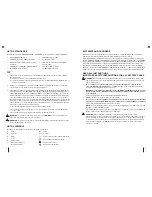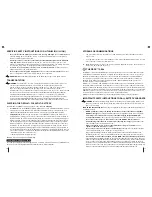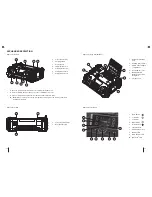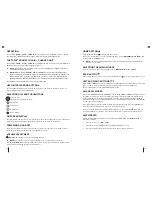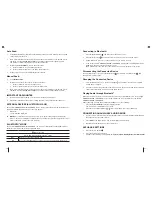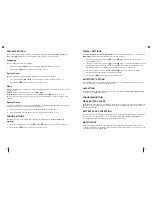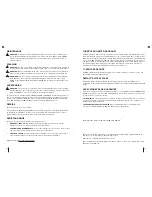
10
11
EN
EN
EN
EN
SPECIFIC SAFETY INSTRUCTIONS FOR LITHIUM ION (LI-ION)
•
Do not incinerate the battery pack even if it is severely damaged or is completely worn
out.
The battery pack can explode in a fire. Toxic fumes and materials are created when
lithium ion battery packs are burned.
•
If battery contents come into contact with the skin, immediately wash area with mild
soap and water.
If battery liquid gets into the eye, rinse water over the open eye for 15
minutes or until irritation ceases. Additionally, seek medical attention. The battery electrolyte
is composed of a mixture of liquid organic carbonates and lithium salts.
•
Contents of opened battery cells may cause respiratory irritation
. Provide fresh air. If
symptoms persist, seek medical attention.
•
Do not expose a battery pack or appliance to fire or excessive temperature.
Exposure
to fire or temperature above 266 °F (130 °C) may cause explosion.
WARNING:
Burn hazard. Battery liquid may be flammable if exposed to spark or flame.
TRANSPORTATION
WARNING:
Fire hazard. Do not store or carry the battery pack so that metal objects can
contact exposed battery terminals. For example, do not place the battery pack in
aprons, pockets, toolboxes, product kit boxes, drawers, etc., with loose nails, screws,
keys, etc. Transporting batteries can possibly cause fires if the battery terminals
inadvertently come in contact with conductive materials such as keys, coins, hand tools and
the like. The US Department of Transportation Hazardous Material Regulations (HMR)
actually prohibits transporting batteries in commerce or on airplanes (e.g., packed in
suitcases and carry-on luggage) UNLESS they are properly protected from short circuits.
So, when transporting individual battery packs, make sure that the battery terminals are
protected and well insulated from materials that could contact them and cause a short circuit.
SHIPPING THE DEWALT
®
FLEXVOLT
®
BATTERY
The DEWALT
®
FLEXVOLT
®
battery has two modes:
Use
and
Shipping.
•
Use Mode:
When the FLEXVOLT
®
battery stands alone or is in a DEWALT
®
20V Max* product,
it will operate as a 20V Max* battery. When the FLEXVOLT
®
battery is in a 60V Max** or a
120V Max* (two 60V Max** batteries) product, it will operate as a 60V Max** battery.
•
Shipping Mode:
When the cap is attached to the FLEXVOLT
®
battery, the battery is in
Shipping Mode. Strings of cells are electrically disconnected within the pack resulting in
three batteries with a lower watt hour (Wh) rating as compared to one battery with a higher
Watt hour rating. This increased quantity of three batteries with the lower watt hour rating
can exempt the pack from certain shipping regulations that are imposed upon the higher
Watt hour batteries. The battery label indicates two-Watt Hour Ratings (see example).
Depending on how the battery is shipped, the appropriate Whr rating must be used to
determine the applicable shipping requirements. If utilizing the shipping cap, the pack will
be considered 3 batteries at the Whr indicated for “Shipping”. If shipping without the cap or in
a tool, the pack will be considered one battery at the Watt hour rating indicated next to “Use”.
* indicating 18.2V when inserted into tool.
** indicating 54V when inserted into tool.
Example of Use and Shipping Label Marking
For example, shipping Wh rating might indicate 3 x 40 Wh, meaning 3 batteries of 40-Watt hours
each. The Use Wh rating might indicate 120-Watt hour (1 battery implied).
USE: 120 Wh Shipping: 3 x 40 h
STORAGE RECOMMENDATIONS
.
1
The best storage place is one that is cool and dry, away from direct sunlight and excess
heat or cold.
2.
For long-term storage, it is recommended to store a fully charged battery pack in a cool dry
place out of the charger for optimal results.
Note:
Battery packs should not be stored completely depleted of charge. The battery pack
will need to be recharged before use.
THE RBRC™ SEAL
The RBRC™ (Rechargeable Battery Recycling Corporation) seal on the nickel cadmium, nickel
metal hydride or lithium ion batteries (or battery packs) indicate that the costs to recycle these
batteries (or battery packs) at the end of their useful life have already been paid by DEWALT
®
.
In some areas, it is illegal to place spent nickel cadmium, nickel metal hydride or lithium ion
batteries in the trash or municipal solid waste stream, and the RBRC program provides an
environmentally conscious alternative.
RBRC™, in cooperation with DEWALT
®
and other battery users, has established programs in
the United States and Canada to facilitate the collection of spent nickel cadmium, nickel metal
hydride or lithium ion batteries. Help protect our environment and conserve natural resources by
returning the spent nickel cadmium, nickel metal hydride or lithium ion batteries to an authorized
DEWALT
®
service center or to your local retailer for recycling. You may also contact your local
recycling center for information on where to drop off the spent battery.
RBRC™ is a registered trademark of the Rechargeable Battery Recycling Corporation.
IMPORTANT SAFETY INSTRUCTIONS FOR ALL BATTERY CHARGERS
WARNING:
Read all safety warnings and all instructions for the battery pack, charger and
power tool. Failure to follow the warnings and instructions may result in electric shock, fire
and/ or serious injury.
SAVE THESE INSTRUCTIONS:
This manual contains important safety and operating instructions
for battery chargers.
•
DO NOT attempt to charge the battery pack with any charger other than a compatible
DEWALT
®
charger.
The charger and battery pack are specifically designed to work together.
•
This charger is not intended for any uses other than charging designated DEWALT
®
rechargeable batteries
. Any other uses may result in risk of fire, electric shock or electrocution.
•
Do not expose the charger to direct water source and DO NOT immerse in water.
•
Pull by the plug rather than the cord when disconnecting the charger.
This will reduce the
risk of damage to the electric plug and cord.
•
Make sure that the cord is located so that it will not be stepped on, tripped over or
otherwise subjected to damage or stress.
•
Do not use an extension cord unless it is absolutely necessary.
Use of improper extension
cord could result in risk of fire, electric shock or electrocution.
•
When operating a charger outdoors, always provide a dry location and use an extension cord
suitable for outdoor use. Use of a cord suitable for outdoor use reduces the risk of electric shock.
•
An extension cord must have adequate wire size (AWG or American Wire Gauge) for safety.
The smaller the gauge number of the wire, the greater the capacity of the cable, that is, 16 gauge
has more capacity than 18 gauge. An undersized cord will cause a drop in line voltage resulting
in loss of power and overheating. When using more than one extension to make up the total
length, be sure each individual extension contains at least the minimum wire size. The following
table shows the correct size to use depending on cord length and nameplate ampere rating. If in
doubt, use the next heavier gauge. The lower the gauge number, the heavier the cord.

